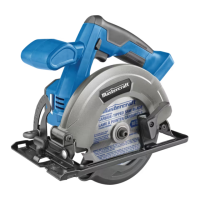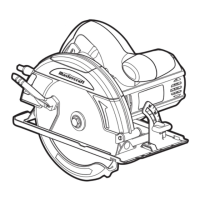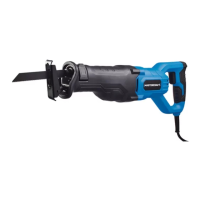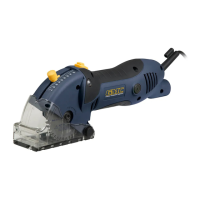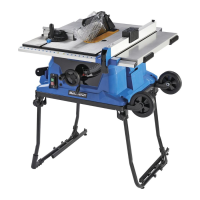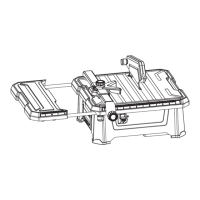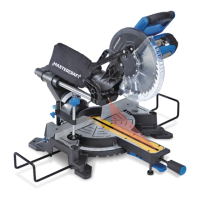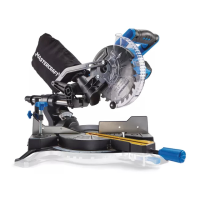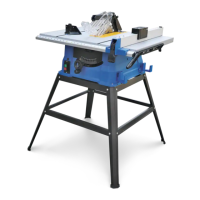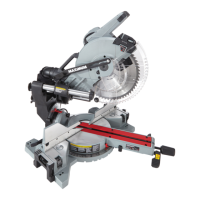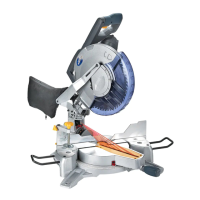headline bars
continuation tabs
notes
warnings
model no. 054-8363-0 | contact us 1.800.689.9928
15
14
SAW BLADES
All saw blades need to be kept clean, sharp and properly set in order to cut efficiently. Using a dull blade
places a heavy load on the saw and increases the danger of kickback. Keep extra blades on hand, so sharp
blades are always available. Gum and wood pitch hardened on the blade slows the saw down. Use gum and
pitch remover, hot water or kerosene to remove them. Do not use gasoline.
KICKBACK
Kickback occurs when the blade stalls rapidly and the
saw is driven back towards you. Blade stalling is caused
by any action that pinches the blade in the wood (fig 3).
TO GUARD AGAINST KICKBACK,
AVOID DANGEROUS PRACTICES SUCH
AS THE FOLLOWING:
1. Setting blade depth incorrectly.
2. Sawing into knots or nails in the workpiece.
3. Twisting the blade while making a cut.
4. Making a cut with a dull, gummed up or improperly
set blade.
5. Supporting the workpiece incorrectly (fig 4).
6. Forcing a cut.
7. Cutting warped or wet lumber.
8. Operating the tool incorrectly or misusing the tool.
9. Attempting to cut with blade at less than full speed.
TO LESSEN THE CHANCE OF
KICKBACK, FOLLOW THESE
DIRECTIONS:
1. Keep the blade at the correct depth setting. The depth
setting should not exceed 1/4 inch below the material
being cut (fig 5).
2. Inspect the workpiece for knots or nails before
cutting. Never saw into a knot or nail.
3. Make straight cuts. Always use a straight edge guide
when rip cutting. This helps prevent twisting of the
blade.
4. Use clean, sharp and properly set blades. Never
make cuts with dull blades.
5. Support the workpiece properly before beginning a
cut (fig 6).
6. Use steady, even pressure when making a cut. Never
force a cut.
7. Do not cut warped or wet lumber.
8. Hold the saw firmly with both hands and keep your body in a balanced position so as to resist the forces if
kickback should occur.
INTEGRATED RIP AND CROSSCUT RULERS
Marked along the base across the front of the saw is a ruler for measuring repetitive cuts. It is marked 5
inches to the right of 0° in 1/8 inch increments.
IMPORTANT INFORMATION
IMPORTANT INFORMATION
WARNING!
• A 7-1/4 inches blade is the maximum blade capacity of your saw. A blade larger than
7-1/4 inches will come in contact with the blade guards. Never use a blade that is so thick
that it prevents the outer blade washer from engaging with the flat side of the spindle.
Blades that are too large or too thick can result in an accident causing serious injury.
• If the blade comes in contact with the workpiece before it reaches full speed, it could
cause the saw to “kickback” towards you, which could result in serious injury.
WARNING!
• To avoid kickback, release the trigger switch immediately if blade binds or saw stalls.
Kickback could cause you to lose control of the saw. Loss of control can lead to serious
injury.
fig 3
Kickback-Blade set too deep
fig 4
WRONG
INCORRECT SUPPORT
fig 5
No more than 1/4 inch
Correct blade depth setting-blade exposed
1/4-in. or less on underside of workpiece
fig 6
CORRECT SUPPORT
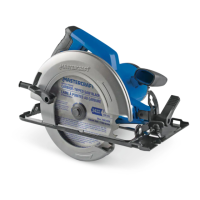
